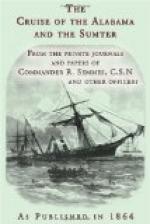We were now introduced to Capt. Semmes, who up to this time had been engaged in the cabin with Mr. W.J. Anderson, of Anderson, Saxon, and Co., upon the subject of supplies, which are to be provided by the firm. We received a very cordial greeting from the gallant gentleman, who remarked that at Bahia, and indeed everywhere he had been, both his officers and himself had received very great attention from the English residents. We had always concluded that Captain Semmes, of the Powhattan, a fine steamer belonging to the States, to whom we were introduced some years since by the late Mr. D.M. Huckins, American Consul, was the captain of the Sumter and Alabama; but we found we were mistaken, and on remarking this to the captain, he said, “Captain Semmes of the Powhattan is of the same family as myself—he is, indeed, my cousin; but he was born in the North, his interests are all there, and he remains in the Federal service.” Having desired us to take a seat, he said he should be happy to give us any information in his power; he had no secrets, and bade us take notes if we wished so to do. He then informed us that he had taken fifteen ships since he left Bahia. We told him that Captain Bartlett, of the ship Fortuna, stated that on the 2d of July he saw a ship on fire. Our readers will recollect that the particulars were given in a paragraph immediately after the Fortuna arrived. It was as follows:—“On the 2d of July, Captain Bartlett saw some smoke rising up on the horizon, which he supposed to be the smoke from a steamer. Later in the day, however, a strong reflection of light was seen in the sky, and which the captain at once believed to be a ship on fire. All hands were then called up ‘to bout ship,’ and they stood towards the spot from whence the light proceeded. This was about six o’clock; and at two o’clock on the morning of the 3d July, and in lat. 25 deg. 57’ South, and in long. 38 deg. 20’ West, the Fortuna ran up within forty yards of a large vessel of 800 or 1000 tons, which was enveloped in one mass of flame from stem to stern. Nothing remained of her but her hull; the whole of her rigging, masts, and decks had already been consumed. As the Fortuna ran towards the wreck, another vessel—the Oaks—bound to Calcutta, joined her, and the two vessels spoke one another. From what Captain Bartlett could make out, the captain of the Oaks told him that in the evening, about half-past six, an English man-of-war had passed him, and whilst passing she fired two guns, from which it was concluded that the crew of the burning vessel had been rescued by the man-of-war.” Captain Semmes said Captain Bartlett was quite right in supposing that the ship had been set on fire by himself. She was the Annie F. Schmidt, from New York to San Francisco, with a general cargo on board; but the supposition of the man-of-war coming to the rescue of the crew was a mistake. “We set her on fire in the night,” said Captain Semmes, “and shortly after we had done so, we heard a couple of guns. We thought it was another Yankee, and we up steam and fired a gun for her to heave-to. On coming alongside her, we found she was Her Majesty’s frigate Dido. ‘We did not take her, sir,’ said the captain, with a laugh; ’in fact, we never attempt to take any of Her Majesty’s frigates.’”




